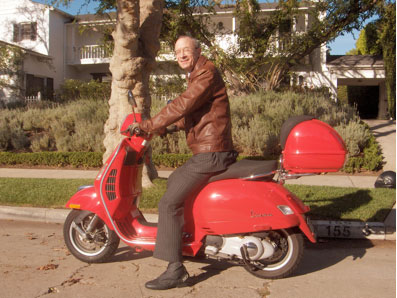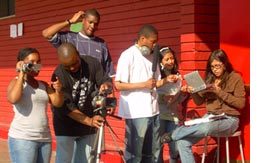Phil’s new red ride
October 31, 2009
Angelenos complain about traffic like urbanites back east complain about the weather. But with apologies to Mark Twain, we’ve found at least one Los Angeles resident with a novel way to actually do something about it.
Phil Hess is a New York transplant who’s lived and worked in L.A. for nearly two decades. For years, the Hancock Park lawyer navigated the city streets as conventionally as the rest of us – comfortably gliding around town encased in his Lexus, but increasingly sweating traffic that seemed to grow exponentially worse by the day.
Today, however, Hess has largely ditched the cushy sedan for a flashier ride: a “Ferrari red” Vespa GTS-250 250-cc motor scooter. And the way he tells it, it was practically love at first sight.
A former planning deputy for retired County Supervisor Ed Edelman, Hess has since built up a thriving private practice as a land-use attorney with cases ranging from Thousand Oaks to the South Bay. “My two most common meetings are meetings with clients or court dates, and the Vespa is essential to be able to do either of those.”
What finally gave him the idea to jump out of the car and onto the scooter?
“I didn’t ditch the car completely,” he admits. “I don’t take the scooter in the rain, and I use the car when I absolutely have to – when I have too much to carry, for example.” But Hess admits that his compulsive New Yorker’s nature can’t abide waiting in traffic – “there, at least it moves; here, it seems to just stop” – and he found LA’s increasingly round-the-clock traffic jams more and more difficult to tolerate.
“What finally snapped my patience,” he says, “was when I had a client in Pacific Palisades with a very complicated land-use issue. There came a time when he couldn’t meet with me until 3 p.m. That evening, I had tickets to a classical concert downtown, and though I left the client at 5:00 p.m., I didn’t get home [to Hancock Park] until 8:15p.”
Anecdotal evidence suggests he’s not alone; Philharmonic officials have long fretted about falling concert attendance among Westsiders due in part to increasingly unmanageable cross-town traffic.
Hess is clearly infatuated with his two-wheel paramour, and eager to show her off.
“The old Vespas were built cheaply and tended to fall apart. They had little two-cycle engines, where you had to mix the gas and oil, and they required a great deal of personal attention to keep running.” As a kid, Hess had plenty of experience with a two-cycle Lambretta, Vespa’s primary competitor. “And if you didn’t get the mix right, ensuring that the engine got enough lubrication, you’d be riding along and the engine would basically seize up into a solid block of metal.”
Subsequent technical advances have largely eliminated that hair-raising possibility while increasing the scooter’s power. What’s more, operating costs are very low. Hess says that, after his roughly $7,000 initial investment, “in three years, I’ve only spent about $300 and tripled my fuel economy.”
So how does a white-collar professional manage to dress for the road and for the board room?
“When I have to meet someone, I get dressed up in layers—I wear well-protective motorcycle boots and stash my dress shoes under the saddle. On a hot day, I’ll put my suit jacket under the saddle and wear a leather jacket. I tried leather chaps once, but they were too uncomfortable.”
Hess concedes that earning a motorcycle license may not be for everyone, with the DMV requiring rigorous testing and training. Then comes the actual practice drills on busy metropolitan streets. Hess shudders at the memory. “You go through six months of absolute terror – Long Beach, Norwalk, Downey, Thousand Oaks. Lomita, Lennox, Hawthorne.” Today, he rides strictly on surface streets: “Although the Vespa technically is freeway legal, it’s totally crazy. I did it once for about 100 yards and got off.”
Cycling safety calls for constant vigilance. “Any kind of spill can be extremely painful,” Hess notes. “The first time I went down, I ripped my suit, and had bruises that took about a month to heal.”
Still, the upsides are considerable, including being able to score great parking spots. “The funny thing is in Italy, where they’re made, nobody rides them anymore – they’re too expensive.”
7 things you should know about the Westside Subway
October 31, 2009
With the Metro board’s recent approval of long range transportation projects for the region, the Westside Subway extension is embarking on an important new stage in its journey. With Santa Monica envisioned as the line’s ultimate destination, there is currently $4.1 billion in local funding, mostly from Measure R, to get it as far as Westwood. Federal dollars will be essential to finish the job.
Some critics of the proposed line argue that it will take too long to build, divert resources from other parts of the region and tunnel through some geological challenges. But proponents, including Supervisor Zev Yaroslavsky, an MTA board member, say the subway’s projected ridership success makes it the best bet for getting federal dollars, particularly since Measure R already is funding projects such as Expo Phase II, the Gold Line/Foothill extension and the Crenshaw Transit Corridor.
Key decisions are still to come on design and technical matters; community meetings are taking place to help determine the placement of stations, and there’s a new video to promote the project (thanks to Steve Hymon for flagging this at Metro’s new blog, The Source.)
So even though the first phase of the project—to Fairfax–won’t be completed until 2019, it’s not too early to know what’s driving the train.
It will go where jobs are.
The Westside has hundreds of thousands of jobs in a relatively concentrated area—currently 429,000 of them, according to the latest mid-year forecast by the Los Angeles County Economic Development Corp.– and commuters who live in outlying areas where housing is more affordable will be able to take advantage of them. That will be a boon to area business owners who’ve long complained about difficulties in hiring and retaining workers frustrated with time-consuming commutes, says Jack Kyser of the Kyser Center for Economic Research, one of the forecast’s authors. A bonus: those jobs are the highest-paying in the county—averaging $66,497 a year. The area also is home to UCLA, the 7th largest employer in the region, with more than 28,000 faculty and staff members.
It will create jobs.
Thousands of jobs will be created. As a rule of thumb, the building trades industry estimates 6,000 construction- and construction-related jobs per $1 billion invested in a project. The exact number of jobs in the long run, however, is hard to predict because those initially hired could stay with the project for multiple years, thus driving down the overall job count.
It will benefit commuters throughout the county.
Metro estimates that 64% of the line’s benefits—a federal formula measuring ridership and time saved–would go to those outside the Westside, with the greatest benefit (22 percent) accruing to the San Gabriel Valley. Metro research shows that more than 310,000 people travel into the Westside from across the region each morning, while 137,000 others leave it and 88,000 travel within it. Meanwhile, UCLA, California’s largest university, is a major area-wide draw with nearly 38,000 students, and the subway extension also has the potential of boosting cross-town access to a variety of major cultural venues, from Disney Hall and the Museum of Contemporary Art (MOCA) to the Los Angeles County Museum of Art and Royce Hall.
It will save thousands of hours in commuting time.
A hypothetical twice-a-day commuter from Koreatown to Westwood would get back the equivalent of eight days in saved commuting time each year by using the subway, according to Metro estimates. Someone commuting from Pasadena would save even more time–12 days a year. To put it another way, that Pasadena commuter currently spending 82 minutes to get from Pasadena to Westwood on public transportation would be able to make the one-way trip in just 50 minutes. “It actually shrinks the city, in a sense,” says David Karwaski, planning and policy manager in UCLA’s Transportation Services Department.
It will help LA to get a greater share of federal transit dollars.
Putting this project in the pipeline sets the stage for Los Angeles to get an allotment that’s more like the New York/New Jersey behemoth, shown in this Metro graphic representing 2010 federal funding for new transit starts. A far more robust showing is possible in the future now that the board has adopted its long range projects priority list. Move over, New York and Salt Lake City. Hello, Los Angeles.
It will help relieve overcrowding on the region’s busiest bus corridor, Wilshire Boulevard.
The Wilshire corridor is the most heavily used bus corridor in the County of Los Angeles, with some 70,000 boardings every weekday from downtown to Santa Monica. With tens of thousands of office workers pouring into the area each day, and bumper-to-bumper traffic at peak hours not only on Wilshire but on the Santa Monica Freeway, the project provides a new option for bus riders while also easing the overall traffic crunch.
It beats taking the 10.
Need we say more?
A creek runs through it
October 30, 2009
Bringing a creek back to life isn’t a job – it’s a commitment for all seasons.
And for the biologists, environmentalists and volunteers who’ve made it their mission to restore Topanga Creek, removing 26,000 tons of concrete and debris last year was just the beginning.
This fall, they’ve moved into planting mode, laying the groundwork—literally—for a rebirth of not just a creek but of an entire ecosystem.
The oaks, sycamores, cottonwoods and other California native plants are still going into the ground, but Rosi Dagit, the driving force behind the project, has seen enough to declare the process a success.“Beyond our wildest dreams, it worked,” says Dagit, senior conservation biologist with the Resource Conservation District of the Santa Monica Mountains. Dagit has spearheaded the creek restoration effort with a huge and varied array of supporting players that includes the Mountains Restoration Trust, the Temescal Canyon Association, TreePeople, the California Conservation Corps and a Sierra Club trail crew.
“It’s huge,” says Jo Kitz, co-executive director of the nonprofit Mountains Restoration Trust, praising Dagit’s tenacity. “I don’t know how many agencies she had to go through to get where we’ve gotten. Once it’s done, it’s just going be one of the brightest spots in the mountains.”
Although the project has been years in the making, progress has been dramatic lately. The first big test of the restoration effort came last winter, with the downpours of December.
Would Topanga Creek return to its natural flow, now that a 1,000-foot-long mound of debris had been leveled? Would the creek once again become a birth canal of sorts for endangered steelhead trout that once flourished in its waters?
Dagit and her team crossed their fingers, jumped in their cars and headed to the creek to see whether their carefully crafted plans would unfold in the natural world as they’d envisioned. They were awestruck.
“It was the coolest thing ever,” says Dagit. “We couldn’t cross the creek because the water level was so high. I was a little weepy.”
The massive project had, in fact, worked to send water racing again through a stretch of the creek that had been rendered largely dry by the concrete berm, originally built four decades ago to protect homes from canyon flood waters. Over the years, residents just kept piling it higher and higher. Tons of backed-up sediments from the berm had literally driven the stream underground. Over the course of the next few years, winter rains will continue the clean-up process, washing sediment out to the shore, Dagit says.
And the steelhead trout, which live in both fresh and salt water, will have a straight shot from creek to ocean—and a swimming chance to repopulate in far greater numbers. What’s more, new habitat has been created for other at-risk creatures, including pond turtles, two types of garter snakes, the California newt and an assortment of frogs.
In all, during three months last fall, 26,000 tons of dirt and debris were hauled away—all of it recycled except for 94 truckloads of hazardous soil. Native plants and trees were protected, and native lupines were planted. The total cost was about $3 million in government grants, including $450,000 from Supervisor Zev Yaroslavsky’s Third District funds.
Over the past year, monthly workdays have drawn volunteers to plant, water and weed. The Conservation Corps recently swooped in to pick up 30 tons of left-behind concrete and 10 tons of asphalt. A Sierra Club trail crew has chopped away invasive non-native plants like arundo.
“It’s an extremely big deal,” Ron Webster, leader of the Sierra Club’s Santa Monica Mountains trail crew, says of the project. “The creek is an incredibly important resource. It’s so rare to have a year-round creek running through the mountains and to the ocean.”
With the creek finally reconnected, the biologists are turning their attention not only to planting but to the progress of the steelhead trout.
Late last year, Dagit and her colleagues tagged 75 to 100 of the endangered fish to track their movements. An antennae was placed in the stream to register each time one of the tagged steelhead passed by on its way to or from Santa Monica Bay. (A warning to would-be poachers: there’s a $25,000 fine for removing steelhead from the creek.) This November, Dagit and her 10-person team are going to hand-capture fish and compare scale samples with those taken last year — an unprecedented way to document the age and growth rate of steelhead in this location.
Eventually, the heavy work of planting will be completed and the focus will shift to another huge undertaking: the clean-up of Topanga Lagoon. But there are moments, as the seasons march by, when Dagit can’t resist stopping to savor the satisfaction of all that’s already been accomplished.
“I actually can’t believe we really did this,” she says. “I’m still pinching myself.”
Stepping up oversight for troubled children
October 30, 2009
 In the wake of several high-profile deaths, the Board of Supervisors has taken steps to improve investigations and accountability at the Department of Children and Family Services and other agencies that intersect the lives of vulnerable youngsters. Two of those measures are focused on technology as a way to strengthen management oversight and improve communication among county agencies. A third aims to improve the diagnostic and forensic examinations of children allegedly abused or neglected.
In the wake of several high-profile deaths, the Board of Supervisors has taken steps to improve investigations and accountability at the Department of Children and Family Services and other agencies that intersect the lives of vulnerable youngsters. Two of those measures are focused on technology as a way to strengthen management oversight and improve communication among county agencies. A third aims to improve the diagnostic and forensic examinations of children allegedly abused or neglected.
Improved Communication: The supervisors, led by Zev Yaroslavsky and Michael D. Antonovich, directed county agencies to immediately start feeding information into and using a computer database created years ago to help social workers with child abuse and neglect investigations. A number of county agencies have not been participating in the system, called the Family and Children’s Index (FCI), as they’d previously agreed to do. Although in place for more than a decade, FCI has been “woefully underutilized,” says Yaroslavsky. But now the agencies have signed memos of understanding, and this month (November), all seven agencies directed to use FCI will ramp up toward full employment of the information-sharing system.
Enhanced Accountability: A new, automated alert system called SafeMeasures will allow DCFS to keep its supervisors better informed of—and more accountable for—cases in which the department has received multiple abuse allegations against a single family. E-mails will be sent to higher ups in the Emergency Response chain of command, for instance, when three or more referrals come in about the same family or when two are received in the same year. Similarly, when social workers determine that a preliminary investigation does not warrant opening a full-blown case, two layers of Emergency Response supervisors will be required to sign off. In addition, supervisors must be notified if social workers have not started an investigation within 15 days after DCFS receives an abuse or neglect allegation.
Broadened Medical Exams: To ensure thorough medical and psychological evaluations of potential victims of child abuse or neglect, the supervisors voted unanimously to look into expanding the categories of children who can be examined by the county’s own medical and psychological experts through the County’s Medical Hub system. Currently, these expert medical and mental health exams are available at the Hubs only after county officials have opened a dependency court case for a child based on suspected abuse or neglect. The new proposal would expand the rules to allow the Hub-based experts to examine children at the earliest stages of an investigation, giving social workers key information to help determine whether to file a case. At present, parents often pick local doctors to examine their children who may not have training in recognizing child abuse or neglect. The change might add another 23,000 exams at the Hubs, more than doubling the current 17,000 according to DCFS. Separately, the board wants to expand the county’s ability to perform forensic psychological and medical examinations of children for use in court cases. The plan would station forensic experts throughout all seven Hubs in the county, shortening travel times for traumatized children.
A new roof for homeless kids and their parents
October 30, 2009
A rundown budget motel in Culver City is being transformed into an oasis for homeless families, a place where they can find emergency housing and comprehensive services designed to stabilize and restore their lives. Set to open in late January, 2010, the Family Shelter, operated by the Santa Monica-based Upward Bound House, will become the first emergency family shelter on the Westside in at least a decade.
“We are filling a real need,” says Upward Bound House Executive Director David Snow.
The $4 million transformation of the former Sunbay Motel on Washington Boulevard will allow it to house as many as 72 homeless adults and kids – an estimated 210 children and their parents each year. Families may come from anywhere in Los Angeles County and remain for up to three months, until they’ve secured permanent housing or moved into a transitional apartment while awaiting a permanent residence.
 Keeping families together during the 90-day transition is the shelter’s goal. “Our entire model is keeping families intact, so each family will have its own unit” housing up to four people, Snow says. He anticipates that most clients will be single-parent families with one, two or three children. The new facility also will feature an on-site playground and a computer lab for kids.
Keeping families together during the 90-day transition is the shelter’s goal. “Our entire model is keeping families intact, so each family will have its own unit” housing up to four people, Snow says. He anticipates that most clients will be single-parent families with one, two or three children. The new facility also will feature an on-site playground and a computer lab for kids.
Beyond safe living spaces, the Upward Bound House Family Shelter will provide comprehensive homeless services, including what Snow calls “wraparound case management” intended to teach adult skills, such as household budgeting, that will help residents succeed on their own.
Families will get two daily meals in a new multi-purpose room, thanks to pledged donations of leftover food from Second Helpings and Google. Youngsters will be enrolled in Culver City or LAUSD schools to ensure continuity.
The Sunbay cost $3 million to acquire, with another $1 million for renovations that will give the facility a contemporary, energy-efficient look, says Jay Vanos, principal at Jay Vanos Architects, which designed the new facility. Vanos’s team is using sustainable materials, is saving cooling costs by blocking excessive sunlight with “eyebrows” over windows and is replacing the old pink and white color scheme with “a warm grey to maintain a quiet low profile” in the neighborhood.
Funding flowed from a variety of sources, a reflection that several cities will benefit from the new facility. Supervisor Zev Yaroslavsky provided $750,000 in Third District funds as seed money. That amount was matched by then-Supervisor Yvonne B. Burke of the Second District, which includes Culver City. The cities of Los Angeles, Santa Monica and Beverly Hills also made contributions.
Sex bias finally arrested in the Sheriff’s Department?
October 30, 2009
 None of the young women who graduated this fall from the sheriff’s academy have met the grandmother who fought their battles, who paved the way for them to comprise 40 percent of their class for the first time in department history.
None of the young women who graduated this fall from the sheriff’s academy have met the grandmother who fought their battles, who paved the way for them to comprise 40 percent of their class for the first time in department history.
If they’ve heard of Susan Bouman at all, it’s only as the name on an aging court case.
Back in 1980, Deputy Bouman filed a federal class-action lawsuit alleging gender discrimination after she was denied a promotion to sergeant. She won the case in 1988 and received $31,500 in back pay, plus benefits.
More important, the case led to a federally-mandated agreement—a consent decree—compelling the department to hire and promote more women and establish a state of the art anti-harassment policy. That victory was much longer in the making.
This fall, nearly two decades after Bouman’s retirement, a federal district court judge quietly lifted a major portion of the consent decree, verifying that the department has successfully put policies in place to effectively guard against sexual harassment. The so-called “equity” portion of the consent decree was the second major victory, following the creation of a gender-neutral sergeant’s exam that won court approval in 2007.
The anti-harassment victory was bittersweet for the 61-year-old former sheriff’s deputy, now known as Susan Paolino. She recalls the years of appeals and foot-dragging that preceded the strides of more recent times. “I think that they’ve made a lot of progress,” says Paolino, who retired as a sergeant in 1990 with a stress disability she attributes to years of fighting the department. “But I’m sorry it’s taken so long.”
Undersheriff Larry Waldie, who oversees compliance with the so-called Bouman decree, points proudly to the department’s harassment policy “as a model for other departments.” But he acknowledges that, for years, the department “chose to take everything to court” rather than resolve the harassment and promotion problems.
“Quite frankly,” he says, “our old way was not the right way.”
A consent decree is a voluntary but binding pact supervised by a judge, with the defendant and plaintiff agreeing to a series of remedies to correct the contested behavior. In some cases—such as the federal consent decree recently lifted at the LAPD–courts appoint third-party monitors. In this case, the judge ordered the two sides to work matters out between themselves, with the judge as the final arbiter. In all consent decrees, judges can impose sanctions, including fines.
“Everybody asks what’s taken so long,” says Paolino’s attorney, Dennis Harley. The answer, he says, is simple: In the early years of the case, sheriffs Peter Pitchess and Sherman Block “didn’t want anyone telling them what to do.”
Today, women make up nearly 17 percent of the sheriff’s sworn personnel, slightly less than the percentage of women in the LAPD. Paolino credits Sheriff Lee Baca, who assumed office in 1998, for more rapidly upending the old-boy culture.
“When he came in,” Paolino says, “the department began an effort to comply with the consent decree. Before that, they fought it tooth and nail.”
Observers and attorneys familiar with the case agree. “It was a priority for Sheriff Baca to resolve the issues under the consent decree to move the department forward,” says Abby Liebman, founder of the California Women’s Law Center and a former member of the Equity Oversight Panel, created by County Supervisors in 2002 to monitor harassment incidents and recommend discipline within the department.
In the mid-1970s, Paolino, then known as Bouman, was a young deputy who couldn’t win promotion to sergeant, despite scoring well on the exam. Harassment and discrimination were pervasive, she says, a part of the culture. Male colleagues left pornographic pictures lying around and flooded her mailbox with transfer request forms so she’d get the hint and leave.
After her internal appeals failed, she filed her lawsuit. By the time she won, she’d been promoted to sergeant, but male colleagues still behaved badly. “There was more harassment after I was sergeant than before,” she says.
The department, meanwhile, fought the judgment at the Ninth Circuit and the U.S. Supreme Court without success, before entering into the consent decree in 1993.
By then, Paolino had retired and started law school. She practiced gender-discrimination law in Whittier and, among her cases, successfully sued Los Angeles County on behalf of female lifeguards who’d been harassed by their male colleagues. Retiring from the law earlier this decade, she moved to San Diego County to help raise a grandchild.
Paolino says she doesn’t hear from women at the Sheriff’s Department but regards herself as a pioneer, saying her suit has “made a big difference” in the department’s gender policies and practices.
Still, two hurdles remain before the consent decree can be vacated entirely.
One concerns ending gender bias in the hiring of entry-level deputies. To increase numbers, the department is aiming at a goal of averaging 20.11 percent women for each graduating class. The department has reached that number in every class since July 2008, with two most recent graduations this fall hitting the 40 percent mark. The department also is revising the physical fitness and firearms tests to level the playing field for women.
“They seem to be working hard to get females through the academy now,” Paolino says.
The other remaining hurdle involves the hiring of women into 51 “coveted positions,” key deputy positions that can serve as stepping stones for eventual promotion to sergeant. To be certain that the job requirements don’t favor men, the department has hired outside experts to “validate” new tests for each position. Only one of the jobs has been validated so far, with a second following in a few weeks. Attorneys on both sides expect the pace to accelerate markedly next year.
In the meantime, the department’s interim goal is to have the percentage of women in those coveted positions be proportional to their overall representation in the department—currently, a lag of about two percentage points that sheriff’s officials hope to fix next year, says Capt. Larry Brogan of the Sheriff’s Labor Relations and Compliance section.
If the department remains on track, the decree could be lifted by mid 2012. For her part, Paolino is optimistic but retains the wary perspective of a battle-scarred veteran.
“I’ve got a 30 year history with this,” she says. “I was seen inside the department as a three-headed monster.”
Expo delays mean possible “partial opening” next year *
October 29, 2009
The new Expo Line, originally envisioned to be up and running from downtown Los Angeles to Culver City by next summer, is now expected to open sometime in 2011. But efforts are underway to determine whether a “partial opening” of the light rail line—perhaps as far as the Crenshaw station—can take place before the end of next year.
The shifting timetable means that the Culver City station is not expected to open until 2012.
Meanwhile, work is progressing on the final environmental impact report for Phase 2 of the project, which would extend the line from Culver City to Santa Monica.
Responding to direction from Supervisor Zev Yaroslavsky, the Expo staff is now working with community groups to resolve concerns about traffic, grade crossing safety, proposed parking restrictions on Westwood Boulevard and Overland Avenue, and the line’s proposed Santa Monica maintenance facility.
“We are working with the communities to address their concerns,” says Expo spokeswoman Gabriela G. Collins.
The Exposition Construction Authority’s board will be asked to approve the final environmental impact report for Phase 2 at its January meeting.
When completed, Phase 1 of the Expo Line will be roughly 8.6 miles in length and parallel the heavily congested Santa Monica Freeway. The estimated travel time from downtown Los Angeles to Culver City will be less than 30 minutes, with a projected ridership of 27,000 by 2020. By the time Phase 2 is complete, it would possible to travel the entire length of the line—from the 7th Street station downtown to Santa Monica—in 44 to 50 minutes. The total ridership is expected to reach up to 64,000 a day by 2030.
Expo officials describe the line as a “Transit Parkway” that will include bike and pedestrian paths, as well as trees and landscaping along the alignment.
Transportation projects tend to move slowly, but those seeking a jolt of instant gratification can take a video ride on the Expo line, courtesy of this clip created by the Urban Simulation Team at UCLA.
Other information about the project is available at here.
Updated 12/16:
With the final environmental impact report on Phase 2 of the Expo Line expected to be released later this week, the Exposition Metro Line Construction Authority has agreed to postpone till Feb. 4 the Expo board’s vote on the plan.
The delay, requested by Los Angeles City Councilmembers Paul Koretz and Bill Rosendahl and supported by Los Angeles County Supervisor Zev Yaroslavsky, will allow more time for interested residents and community and elected leaders to review the plan before it comes before the Expo board.
Once the final environmental impact report is certified by the board, a contractor can be selected and the construction phase will begin.
Updated 12/21:
The final environmental impact report for Expo Phase 2 has been released. Read it here. The Exposition Construction Authority’s Board of Directors will consider it on Thursday, February 4. The meeting will start at 2 p.m. and will be held in the Board of Supervisors’ hearing room on the third floor of the Kenneth Hahn Hall of Administration, 500 W. Temple Street, Los Angeles, 90012.
Not so much trouble in Paradise (Cove)
October 29, 2009
They set out to solve one mystery, but they ended up with another.
First, the good news: An unusual three-year research partnership has found that the water quality at Malibu’s Escondido and Paradise Cove beaches is dramatically better than expected. Now the puzzling news: Nobody knows why.
“It’s like you hired Scotland Yard to solve a murder and three weeks later the dead person walks in and says, ‘Whatcha doing?’ ” says Steve Weisberg, executive director of the Southern California Coastal Water Research Project, which is running the study with $800,000 in funding from Los Angeles County. “We were hired to find the source of the problem….Where we’re at is a point of frustration.”
When the project started in May, 2006, the targeted beaches stood out as significant problem areas, according to Mark Gold, president of Heal the Bay, which has participated in the research along with the county Department of Public Works.
“Escondido was the most polluted beach we had ever seen,” Gold says. On the group’s annual Beach Report Card, he says, “I think it got a zero one year.” (Now Escondido Creek, just east of Escondido State Beach, and Paradise Cove Pier at Ramirez Canyon Creek mouth are both on the group’s honor roll.)
Back then, Gold suspected that the pollution was coming from “illegal dumping of tremendous amounts of horse manure” and maybe also from waste discharge problems from a nearby restaurant and some mobile homes.
All this added up to an opportunity for some collaborative detective work, bringing together the county and its sometime-adversary Heal the Bay, which has pushed hard for more aggressive government enforcement of clean water regulations.
The Southern California Water Research Project was “brought in as a neutral party,” Weisberg says, adding that he thought the best way to achieve a détente was to have everyone in the field “taking samples together.”
At their disposal was an array of scientific tools – including tests for optical brighteners found in laundry detergent to learn if household wastewater was involved. (For more on those, click here.) Overall, the prospects for finally determining whodunit (or whatdunit) looked good.
“The problem,” Weisberg says, “is that we just have not found strong, recurrent problems at that beach.”
One theory holds that a series of unusually dry winters led to a temporary improvement in the bacteria levels flowing from Escondido and Ramirez creeks into the bay. Another scenario posits that someone was illegally dumping, found out about the study in progress and decided to clean up his or her act. Or maybe different testing methods yield a different result? “We don’t know,” Weisberg says, “but we know it stopped.”
Weisberg says the hunt will continue in the coming year, with some discussion of testing to determine whether “birds pooping on the beach” mighty be to blame for the pollution, rather than problems in the watershed.
Gold, for his part, thinks it’s probably not worth continuing the testing effort unless there’s significantly more rainfall this year, which would bring more runoff to analyze. He does, however, advocate keeping an eye on a restaurant at the “very lowest part of the watershed.”
“You never get to pack your bags and go home,” says Gold, who praises Supervisor Zev Yaroslavsky for responding to long-running concerns about the beaches’ bacteria levels and pushing for funds to study the problem. “I’m glad we did it,” Gold says. “I think it put a lot of people’s minds at ease.”
Mark Pestrella, deputy director of water resources for the county Department of Public Works, says he also is glad the study went forward and wants to see it continue for a fourth year. “The supervisors and the constituents out there really want to know that these beaches are safe,” Pestrella says.
“The study helped us set up protocols that were not in place before….Methods of sampling, the health department’s and Heal the Bay’s, were tried side by side,” he says. “It gave us more information on the percentage of the problem we should allocate to humans. Although we didn’t actually break down every source, we eliminated several areas. In Escondido, we were able to say we did not find a human source of indicator bacteria at the beach.”
The bottom line, Pestrella says, is that the study so far has “bettered the county’s understanding of how to monitor and test for indicator bacteria. It very much put science in front of rhetoric.”
The fine art of saving jobs
October 27, 2009
Against the vast backdrop of the federal stimulus program, $420,084 may not seem like such a massive sum.
 But to Tiffany Gallindo, it’s huge. It means she can keep her job on the front lines of the Ryman Arts program, working to bring a free visual arts education and college guidance to gifted Los Angeles high school students, many of them low-income.
But to Tiffany Gallindo, it’s huge. It means she can keep her job on the front lines of the Ryman Arts program, working to bring a free visual arts education and college guidance to gifted Los Angeles high school students, many of them low-income.
It means that Samuel Jang gets to continue his work as production manager for the Southwest Chamber Music Society, including helping to put together ambitious upcoming tours to Mexico and Vietnam.
And it means that Kenton J. Haleem of the Hollywood Entertainment Museum can bring back a position recently put on “hiatus”—a program manager in the organization’s media arts training program for at-risk kids.
All three organizations recently were singled out for grants of American Recovery and Reinvestment Act (ARRA) funds from the National Endowment for the Arts. The cash infusion comes thanks to the efforts of the Los Angeles County Arts Commission and the City of Los Angeles Department of Cultural Affairs, which together were able to preserve 21 positions in 16 arts organizations.
“The arts are a huge economic engine for our whole region,” says Laura Zucker, executive director of the County Arts Commission. “This is an important employer,” Zucker says, noting that the 300-plus arts organizations that are funded by the county employ more than 21,000 people.
And the importance of the organizations can be measured in more than just paychecks.
At Ryman Arts, a small nonprofit using donated studio space on the USC campus, they’re feeling the economic pains of students and recent alumni first-hand.
“Their calls and needs have been more urgent: Can we point them to more scholarship opportunities because they can’t take on more college loans? Can we arrange for them to stay after class to draw, because the electricity has been turned off at their apartment?” the organization said in its application for the grant. “Can we write another recommendation letter for a college application because they don’t have an art teacher at school?”
On the front lines is Gallindo, handling the phones, shepherding student applications, working to bring the aspiring artists and their work into the fold.
“I actually went to an arts high school,” says Gallindo, a dancer who attended Los Angeles County High School for the Arts and had been working at an insurance company before joining Ryman. “It changed my life and it opened doors. To be a part of something that is providing that opportunity to kids today is very rewarding.” (View recent student artwork on Ryman’s Flickr site).
The grant “just gives us a huge sigh of relief,” says Ryman’s executive director, Diane Brigham. “With the downturn, I had to lay off another position entirely… We’re [now] a four-person organization. And I’m really glad we’re not a three-person organization.”At the Southwest Chamber Music Society, there’s a similar mixture of excitement about upcoming projects—and concern about how to carry out an increasingly ambitious mission in an economic downturn.
On the plus side, the Los Angeles Cultural Affairs Department is sponsoring Southwest as it travels later this year to represent the U.S. at the Guadalajara FIL Arts Festival. Even more complex is next year’s State Department-sponsored Ascending Dragon Music Festival and Cultural Exchange, which will include music festivals, educational programs and administrative workshops in the U.S. and Vietnam.
“This is what we’re calling a transformative year for Southwest Chamber Music,” says Executive Director Jan Karlin, “and we needed to bring in someone to manage it.”
But because Southwest is “seeing a substantial decrease in most of our funding sources,” the federal stimulus funds were needed to pay Jang’s salary, the organization said in its application. He will not only to help manage the upcoming tours but also holds considerable responsibilities for Southwest’s musical and educational outreach throughout Los Angeles County.
Jang, whose background is in financial systems analysis and who served on Southwest’s board as treasurer before joining its staff, says he is relishing the change in perspective that comes with his new position.
“Having come from the financial services world—one of the casualties of this recession—it’s a really eye-opening opportunity for me,” he says. Working with “staff, musicians and audiences puts a more human face on this organization. Just last week, I coordinated the start of our music educational program at Keppel and Pasadena high schools.”
Across town, the Hollywood Entertainment Museum has been trying to help a new generation write its own kind of history, as 75 high school students—many of them dropouts, on probation, or otherwise “at risk”—learn the ropes of entertainment industry trades. The museum’s educational arm, the Hollywood Media Arts Academy, which is a collaboration with L.A. County Office of Education and the Probation Department, combines core academics with elective classes, including animation, dance, film production and acting.
The federal grant “can’t come soon enough,” says Haleem, the organization’s director of education and development, who says the group’s program manager had been placed on “somewhat of a hiatus.” Now that there’s money to rehire, he says, “I’m hoping she’s still available.”
“Things are tough right now,” he says. “I think that is the story of the nonprofits right now.”
In all, the NEA gave out 630 direct grants totaling $29.7 million, with $4.45 million going to California, including funds provided to the city and county commissions.To view a full list of the county and city grants, click here.




























 Check for the latest closure information
Check for the latest closure information








